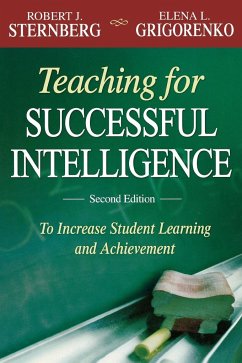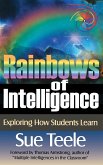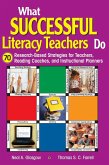Robert J. Sternberg, Elena L. Grigorenko
Teaching for Successful Intelligence
To Increase Student Learning and Achievement
Robert J. Sternberg, Elena L. Grigorenko
Teaching for Successful Intelligence
To Increase Student Learning and Achievement
- Gebundenes Buch
- Merkliste
- Auf die Merkliste
- Bewerten Bewerten
- Teilen
- Produkt teilen
- Produkterinnerung
- Produkterinnerung
Provides 40 research-based, illustrated lessons and demonstrates how to design units that help students apply analytical, creative, and practical thinking skills to solve problems and make decisions.
Andere Kunden interessierten sich auch für
![Rainbows of Intelligence Rainbows of Intelligence]() Sue TeeleRainbows of Intelligence82,99 €
Sue TeeleRainbows of Intelligence82,99 €![A Passion for Teaching A Passion for Teaching]() Christopher DayA Passion for Teaching215,99 €
Christopher DayA Passion for Teaching215,99 €![Toward Successful School Crisis Intervention Toward Successful School Crisis Intervention]() Charles M. Jaksec IiiToward Successful School Crisis Intervention71,99 €
Charles M. Jaksec IiiToward Successful School Crisis Intervention71,99 €![The Teacher's Guide to Successful Job Transfers and Promotions The Teacher's Guide to Successful Job Transfers and Promotions]() Joanne Wachter GhioThe Teacher's Guide to Successful Job Transfers and Promotions56,99 €
Joanne Wachter GhioThe Teacher's Guide to Successful Job Transfers and Promotions56,99 €![EQ + IQ = Best Leadership Practices for Caring and Successful Schools EQ + IQ = Best Leadership Practices for Caring and Successful Schools]() Maurice J. EliasEQ + IQ = Best Leadership Practices for Caring and Successful Schools79,99 €
Maurice J. EliasEQ + IQ = Best Leadership Practices for Caring and Successful Schools79,99 €![What Successful Literacy Teachers Do What Successful Literacy Teachers Do]() Neal A. GlasgowWhat Successful Literacy Teachers Do87,99 €
Neal A. GlasgowWhat Successful Literacy Teachers Do87,99 €![The Educator's Guide to Emotional Intelligence and Academic Achievement The Educator's Guide to Emotional Intelligence and Academic Achievement]() Maurice J. EliasThe Educator's Guide to Emotional Intelligence and Academic Achievement102,99 €
Maurice J. EliasThe Educator's Guide to Emotional Intelligence and Academic Achievement102,99 €-
-
-
Provides 40 research-based, illustrated lessons and demonstrates how to design units that help students apply analytical, creative, and practical thinking skills to solve problems and make decisions.
Hinweis: Dieser Artikel kann nur an eine deutsche Lieferadresse ausgeliefert werden.
Hinweis: Dieser Artikel kann nur an eine deutsche Lieferadresse ausgeliefert werden.
Produktdetails
- Produktdetails
- Verlag: Corwin
- 2. Auflage
- Seitenzahl: 216
- Erscheinungstermin: 12. Juli 2007
- Englisch
- Abmessung: 260mm x 183mm x 16mm
- Gewicht: 610g
- ISBN-13: 9781412955812
- ISBN-10: 1412955815
- Artikelnr.: 22697427
- Herstellerkennzeichnung
- Libri GmbH
- Europaallee 1
- 36244 Bad Hersfeld
- gpsr@libri.de
- Verlag: Corwin
- 2. Auflage
- Seitenzahl: 216
- Erscheinungstermin: 12. Juli 2007
- Englisch
- Abmessung: 260mm x 183mm x 16mm
- Gewicht: 610g
- ISBN-13: 9781412955812
- ISBN-10: 1412955815
- Artikelnr.: 22697427
- Herstellerkennzeichnung
- Libri GmbH
- Europaallee 1
- 36244 Bad Hersfeld
- gpsr@libri.de
Robert J. Sternberg is Professor of Human Development at Cornell University and Honorary Professor of Psychology at the University of Heidelberg, Germany. He formerly was IBM Professor of Psychology and Education at Yale. His BA is from Yale summa cum laude and his PhD is from Stanford. He also holds 13 honorary doctorates. He is a member of the National Academy of Education and the American Academy of Arts and Sciences. Sternberg has been cited over 150,000 times and is among the most frequently cited authors in psychology textbooks. He is the winner of the APS Williams James Award and the APS James McKeen Cattell Award and of the Grawemeyer Award in Psychology. He is married to Karin Sternberg and has five children: Seth, Sara, Samuel, Brittany, and Melody.
Preface Introduction About the Authors Part I. Understanding Successful Intelligence 1. What Is Successful Intelligence? A Grizzly Bear
s Lunch Defining Successful Intelligence The Triarchy of Thinking Abilities Conclusion 2. Examining the Theory of Successful Intelligence Does Successful Intelligence Work in the Classroom? Why Are Conventional Notions of Intelligence Still Prevalent? 3. Successful Intelligence in Life and in School Successful Intelligence in Life: The Changing Demands of the Larger World Successful Intelligence in School: Giving Everybody a Fair Chance Part II. Building Successful Intelligence Abilities 4. Teaching for Analytical Thinking Problem Solving Lesson 1: Identify Problem Lesson 2: Allocate Resources Lesson 3: Represent and Organize Information Lesson 4: Formulate Strategy Lesson 5: Monitor Problem Solving Strategies Lesson 6: Evaluate Solutions Lesson 7: Additional Prompts for Analytical Thinking 5. Teaching for Creative Thinking The Investment View of Creativity: Buying Low and Selling High Balancing Analytical, Creative, and Practical Abilities Lesson 8: Redefine the Problem Lesson 9: Question and Analyze Assumptions Lesson 10: Sell Creative Ideas Lesson 11: Generate Ideas Lesson 12: Recognize the Two Faces of Knowledge Lesson 13: Identify and Surmount Obstacles Lesson 14: Take Sensible Risks Lesson 15: Tolerate Ambiguity Lesson 16: Build Self-Efficacy Lesson 17: Uncover True Interests Lesson 18: Delay Gratification Lesson 19: Model Creativity Lesson 20: Additional Prompts for Creative Thinking 6. Teaching for Practical Thinking Lesson 21: Become Motivated Lesson 22: Control Impulses Lesson 23: Persevere but Don
t Perseverate Lesson 24: Use the Right Abilities Lesson 25: Act on a Plan Lesson 26: Become Oriented to Product Lesson 27: Complete Tasks Lesson 28: Make a Commitment Lesson 29: Take a Risk Lesson 30: Don
t Procrastinate Lesson 31: Assign Responsibility Lesson 32: Manage Self-Pity Lesson 33: Be Independent Lesson 34: Handle Personal Difficulties Lesson 35: Concentrate Lesson 36: Schedule Accordingly Lesson 37: Set Priorities Lesson 38: Balance Thinking Skills Lesson 39: Develop Self-Confidence Lesson 40: Additional Prompts for Practical Thinking Part III. Developing Successful Intelligence Units 7. Framing Triarchic Instruction and Assessment Units The Nuts and Bolts of TIA What TIA Means What TIA Does Not Mean The Structure of TIA Units Pre-TIA Activities Designing a TIA Unit Implementing TIA 8. Putting It All Together: A Comprehensive Illustration of Lessons for Teaching for Successful Intelligence Introduction to Unit Unit Lesson 1: Introduction Unit Lesson 2: Analytical Unit Lesson 3: Practical Unit Lesson 4: Creative Unit Homework Unit Assessment Conclusion Appendix: Grade Level Activities References Index
s Lunch Defining Successful Intelligence The Triarchy of Thinking Abilities Conclusion 2. Examining the Theory of Successful Intelligence Does Successful Intelligence Work in the Classroom? Why Are Conventional Notions of Intelligence Still Prevalent? 3. Successful Intelligence in Life and in School Successful Intelligence in Life: The Changing Demands of the Larger World Successful Intelligence in School: Giving Everybody a Fair Chance Part II. Building Successful Intelligence Abilities 4. Teaching for Analytical Thinking Problem Solving Lesson 1: Identify Problem Lesson 2: Allocate Resources Lesson 3: Represent and Organize Information Lesson 4: Formulate Strategy Lesson 5: Monitor Problem Solving Strategies Lesson 6: Evaluate Solutions Lesson 7: Additional Prompts for Analytical Thinking 5. Teaching for Creative Thinking The Investment View of Creativity: Buying Low and Selling High Balancing Analytical, Creative, and Practical Abilities Lesson 8: Redefine the Problem Lesson 9: Question and Analyze Assumptions Lesson 10: Sell Creative Ideas Lesson 11: Generate Ideas Lesson 12: Recognize the Two Faces of Knowledge Lesson 13: Identify and Surmount Obstacles Lesson 14: Take Sensible Risks Lesson 15: Tolerate Ambiguity Lesson 16: Build Self-Efficacy Lesson 17: Uncover True Interests Lesson 18: Delay Gratification Lesson 19: Model Creativity Lesson 20: Additional Prompts for Creative Thinking 6. Teaching for Practical Thinking Lesson 21: Become Motivated Lesson 22: Control Impulses Lesson 23: Persevere but Don
t Perseverate Lesson 24: Use the Right Abilities Lesson 25: Act on a Plan Lesson 26: Become Oriented to Product Lesson 27: Complete Tasks Lesson 28: Make a Commitment Lesson 29: Take a Risk Lesson 30: Don
t Procrastinate Lesson 31: Assign Responsibility Lesson 32: Manage Self-Pity Lesson 33: Be Independent Lesson 34: Handle Personal Difficulties Lesson 35: Concentrate Lesson 36: Schedule Accordingly Lesson 37: Set Priorities Lesson 38: Balance Thinking Skills Lesson 39: Develop Self-Confidence Lesson 40: Additional Prompts for Practical Thinking Part III. Developing Successful Intelligence Units 7. Framing Triarchic Instruction and Assessment Units The Nuts and Bolts of TIA What TIA Means What TIA Does Not Mean The Structure of TIA Units Pre-TIA Activities Designing a TIA Unit Implementing TIA 8. Putting It All Together: A Comprehensive Illustration of Lessons for Teaching for Successful Intelligence Introduction to Unit Unit Lesson 1: Introduction Unit Lesson 2: Analytical Unit Lesson 3: Practical Unit Lesson 4: Creative Unit Homework Unit Assessment Conclusion Appendix: Grade Level Activities References Index
Preface Introduction About the Authors Part I. Understanding Successful Intelligence 1. What Is Successful Intelligence? A Grizzly Bear
s Lunch Defining Successful Intelligence The Triarchy of Thinking Abilities Conclusion 2. Examining the Theory of Successful Intelligence Does Successful Intelligence Work in the Classroom? Why Are Conventional Notions of Intelligence Still Prevalent? 3. Successful Intelligence in Life and in School Successful Intelligence in Life: The Changing Demands of the Larger World Successful Intelligence in School: Giving Everybody a Fair Chance Part II. Building Successful Intelligence Abilities 4. Teaching for Analytical Thinking Problem Solving Lesson 1: Identify Problem Lesson 2: Allocate Resources Lesson 3: Represent and Organize Information Lesson 4: Formulate Strategy Lesson 5: Monitor Problem Solving Strategies Lesson 6: Evaluate Solutions Lesson 7: Additional Prompts for Analytical Thinking 5. Teaching for Creative Thinking The Investment View of Creativity: Buying Low and Selling High Balancing Analytical, Creative, and Practical Abilities Lesson 8: Redefine the Problem Lesson 9: Question and Analyze Assumptions Lesson 10: Sell Creative Ideas Lesson 11: Generate Ideas Lesson 12: Recognize the Two Faces of Knowledge Lesson 13: Identify and Surmount Obstacles Lesson 14: Take Sensible Risks Lesson 15: Tolerate Ambiguity Lesson 16: Build Self-Efficacy Lesson 17: Uncover True Interests Lesson 18: Delay Gratification Lesson 19: Model Creativity Lesson 20: Additional Prompts for Creative Thinking 6. Teaching for Practical Thinking Lesson 21: Become Motivated Lesson 22: Control Impulses Lesson 23: Persevere but Don
t Perseverate Lesson 24: Use the Right Abilities Lesson 25: Act on a Plan Lesson 26: Become Oriented to Product Lesson 27: Complete Tasks Lesson 28: Make a Commitment Lesson 29: Take a Risk Lesson 30: Don
t Procrastinate Lesson 31: Assign Responsibility Lesson 32: Manage Self-Pity Lesson 33: Be Independent Lesson 34: Handle Personal Difficulties Lesson 35: Concentrate Lesson 36: Schedule Accordingly Lesson 37: Set Priorities Lesson 38: Balance Thinking Skills Lesson 39: Develop Self-Confidence Lesson 40: Additional Prompts for Practical Thinking Part III. Developing Successful Intelligence Units 7. Framing Triarchic Instruction and Assessment Units The Nuts and Bolts of TIA What TIA Means What TIA Does Not Mean The Structure of TIA Units Pre-TIA Activities Designing a TIA Unit Implementing TIA 8. Putting It All Together: A Comprehensive Illustration of Lessons for Teaching for Successful Intelligence Introduction to Unit Unit Lesson 1: Introduction Unit Lesson 2: Analytical Unit Lesson 3: Practical Unit Lesson 4: Creative Unit Homework Unit Assessment Conclusion Appendix: Grade Level Activities References Index
s Lunch Defining Successful Intelligence The Triarchy of Thinking Abilities Conclusion 2. Examining the Theory of Successful Intelligence Does Successful Intelligence Work in the Classroom? Why Are Conventional Notions of Intelligence Still Prevalent? 3. Successful Intelligence in Life and in School Successful Intelligence in Life: The Changing Demands of the Larger World Successful Intelligence in School: Giving Everybody a Fair Chance Part II. Building Successful Intelligence Abilities 4. Teaching for Analytical Thinking Problem Solving Lesson 1: Identify Problem Lesson 2: Allocate Resources Lesson 3: Represent and Organize Information Lesson 4: Formulate Strategy Lesson 5: Monitor Problem Solving Strategies Lesson 6: Evaluate Solutions Lesson 7: Additional Prompts for Analytical Thinking 5. Teaching for Creative Thinking The Investment View of Creativity: Buying Low and Selling High Balancing Analytical, Creative, and Practical Abilities Lesson 8: Redefine the Problem Lesson 9: Question and Analyze Assumptions Lesson 10: Sell Creative Ideas Lesson 11: Generate Ideas Lesson 12: Recognize the Two Faces of Knowledge Lesson 13: Identify and Surmount Obstacles Lesson 14: Take Sensible Risks Lesson 15: Tolerate Ambiguity Lesson 16: Build Self-Efficacy Lesson 17: Uncover True Interests Lesson 18: Delay Gratification Lesson 19: Model Creativity Lesson 20: Additional Prompts for Creative Thinking 6. Teaching for Practical Thinking Lesson 21: Become Motivated Lesson 22: Control Impulses Lesson 23: Persevere but Don
t Perseverate Lesson 24: Use the Right Abilities Lesson 25: Act on a Plan Lesson 26: Become Oriented to Product Lesson 27: Complete Tasks Lesson 28: Make a Commitment Lesson 29: Take a Risk Lesson 30: Don
t Procrastinate Lesson 31: Assign Responsibility Lesson 32: Manage Self-Pity Lesson 33: Be Independent Lesson 34: Handle Personal Difficulties Lesson 35: Concentrate Lesson 36: Schedule Accordingly Lesson 37: Set Priorities Lesson 38: Balance Thinking Skills Lesson 39: Develop Self-Confidence Lesson 40: Additional Prompts for Practical Thinking Part III. Developing Successful Intelligence Units 7. Framing Triarchic Instruction and Assessment Units The Nuts and Bolts of TIA What TIA Means What TIA Does Not Mean The Structure of TIA Units Pre-TIA Activities Designing a TIA Unit Implementing TIA 8. Putting It All Together: A Comprehensive Illustration of Lessons for Teaching for Successful Intelligence Introduction to Unit Unit Lesson 1: Introduction Unit Lesson 2: Analytical Unit Lesson 3: Practical Unit Lesson 4: Creative Unit Homework Unit Assessment Conclusion Appendix: Grade Level Activities References Index








